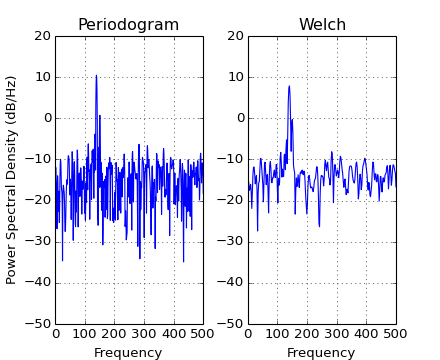

(Source code, png, hires.png, pdf)

#This is a ported version of a MATLAB example from the signal processing
#toolbox that showed some difference at one time between Matplotlib's and
#MATLAB's scaling of the PSD.
import numpy as np
import matplotlib.pyplot as plt
import matplotlib.mlab as mlab
fs = 1000
t = np.linspace(0, 0.3, 301)
A = np.array([2, 8]).reshape(-1, 1)
f = np.array([150, 140]).reshape(-1, 1)
xn = (A * np.sin(2 * np.pi * f * t)).sum(axis=0) + 5 * np.random.randn(*t.shape)
yticks = np.arange(-50, 30, 10)
xticks = np.arange(0,550,100)
plt.subplots_adjust(hspace=0.45, wspace=0.3)
plt.subplot(1,2,1)
plt.psd(xn, NFFT=301, Fs=fs, window=mlab.window_none, pad_to=1024,
scale_by_freq=True)
plt.title('Periodogram')
plt.yticks(yticks)
plt.xticks(xticks)
plt.grid(True)
plt.subplot(1,2,2)
plt.psd(xn, NFFT=150, Fs=fs, window=mlab.window_none, noverlap=75, pad_to=512,
scale_by_freq=True)
plt.title('Welch')
plt.xticks(xticks)
plt.yticks(yticks)
plt.ylabel('')
plt.grid(True)
plt.show()
Keywords: python, matplotlib, pylab, example, codex (see Search examples)